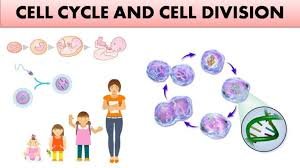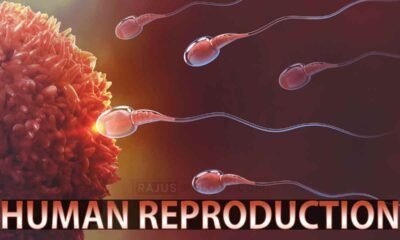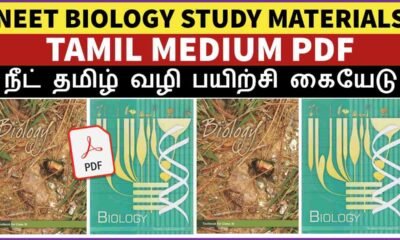Blog
Cell Cycle and Cell Division Notes | Class 11 & NEET Free Notes

In this article we will discuss about Cell Cycle and Cell Division Notes:- What is cell cycle, What is cell division, Amitosis, Mitosis and Meiosis
What is Cell Cycle?
- Cell cycle is series of events involving cell growth and cell division
- Cell growth, DNA replication and cell division constitute a cell cycle
- Events happening in a cell cycle are genetically controlled
- Duration of cell cycle varies in different organisms and different types of cells. The average duration of the human cell cycle is 24 hrs, whereas a yeast cell completes one cell cycle in 90 minutes
- Discovered by Prevost and Dumas (1824)
- Cell cycle is series of events that take place in cell, resulting in the duplication of DNA and division of cytoplasm and organelles to produce two daughter cells
- Cell cycle is divided broadly into 2 phases
- Interphase
- M phase
Interphase
- Interphase is most active phase
- It takes more than 95% time of the cell cycle
- Series of metabolic changes occurs during interphase
- These changes are not visible under microscope, so termed as resting phase
- The Interphase is further divided into G1, S, and G2 phase
I) G1 Phase
- Synthesis of enzymes, RNA, amino acids, ATP and nucleotides occur
- Raw materials synthesis for S phase
- Size of cell is increased
II) S Phase
- DNA replication occurs
- Synthesis of histone protein takes place
- DNA doubles but chromosome number remains same
- If animal cell centriole also duplicates
III) G2 Phase
- Cell prepares itself for division
- Synthesis of proteins and RNA takes place
- ATP synthesis occurs
M Phase
- Cell division occurs in M phase
- This phase has a short duration
- M phase is composed of two processes
i) Karyokinesis
- Division of nucleus into two daughter nuclei
- Four sub stages
- Prophase
- Metaphase
- Anaphase
- Telophase
ii) Cytokinesis
- Division of cytoplasm resulting in two daughter cells
Cell Cycle Checkpoint
- Cell cycle checkpoints are control mechanisms in cell cycle which ensure its proper progression
- Three most important checkpoints
- G1 Checkpoint
- G2 Checkpoint
- M checkpoint
I) G1 Checkpoint
- This checkpoint checks internal and external conditions are right for division
- Check cell size
- Check Enzyme, Protein and ATP are synthesized
- Check DNA damage or not
- If a cell doesn’t get it may leave the cell cycle and enter a resting state called G0 phase
II) G2 Checkpoint
- DNA replication completeness
- Check DNA completely copied or not
- Check Enzyme, Protein and ATP are synthesized
- If errors or damage are detected
- Cell will pause at G2 checkpoint to allow for repairs
- If the damage is irreparable, the cell may undergo apoptosis
III) M Checkpoint
- M checkpoint is also known as the spindle checkpoint
- Chromosome attachment to spindle at metaphase plate
- If chromosome is misplaced, the cell will pauses mitosis, allowing time for spindle to capture the stray chromosome
CELL DIVISION
- Production of daughter cell from parent cell is known as cell division
- Cell division occurs as part of cell cycle
Types of cell division
- Amitosis
- Mitosis
- Meiosis
Amitosis
- Remak discovered amitosis in RBCs of chick embryo
- Term was coined by Flemming
- Also known as direct cell division
- Cell nucleus elongates, constricts in middle and divides directly into two daughter nuclei
- This is followed by constriction of cytoplasm to form two daughter cells
Characteristics of Amitosis
- Occurs in lower organisms like yeast, fungi, bacteria and in amoeba
- Nuclear membrane does not disappear during cell division
- Spindle fibers are not formed during cell division
- Daughter cell does not have equal number of chromosomes
Mitosis
- Mitosis is called as equational division
- No change in number of chromosomes in parent cell & daughter cell
- Two major processes occur during M Phase: Karyokinesis and Cytoinesis
- a) Karyokinesis
- Nucleus division is occurs
- Chromosomes are also separated
- This phase consists of 4 stages
- Prophase
- Metaphase
- Anaphase
- Telophase
I) Prophase
- First stage of mitosis
- Chromatin material starts to condensation and take the shape of chromosomes
- In each chromosome 2 chromatids are attached at centromere
- Nuclear membrane disintegrates
- Each centriole separate and migrates towards opposite pole of cell
- Around centrole astral ray are formed
- In addition longer spindle fibres are formed
- Spindle fibres along with asters known as amphiaster or mitotic apparatus
II) Metaphase
- Condensation of chromosomes is completed & observed clearly under microscope
- Chromosomes lie at the equatorial plane
- Spindle fibres extending from one pole to other are called continuous spindle fibres
- Fibres extending from a pole to centromere of chromosome are called discontinuous spindle fibres
- Metaphase is best stage in mitosis for analyzing chromosomes and to study their morphology
III) Anaphase
- Chromatids of each chromosome are separated and form two chromosomes called daughter chromosomes
- Daughter chromosomes move to opposite poles
- Fibres which develop between the separating centromeres are called interzonal fibres
- Migration of daughter chromosomes due to contraction of spindle fibres and stretching of interzonal fibres
- The chromosomes appear as V, L, J and I shaped depending upon the position of centromere
- At end of anaphase, two groups of chromosomes are formed, one at each pole
- Number of chromosomes at each pole is equal to number of chromosome in the parent nucleus
IV) Telophase
- Final stage of karyokinesis
- Telophase is a reversal of prophase
- Telophase chromosome became decondensed and uncoiled and form chromatin
- Nucleolus, nuclear envelope and nucleoplasm is reformed
- Spindle fibres break down and absorbed in cytoplasm
b) Cytokinesis
- Division of cytoplasm into two daughter cells is called cytokinesis
- Microtubules and microfilaments arrange on equator to form midbody
- Periphery of equator contractile ring formed that is made up of actin and myosin
- Due to actin and myosin contract, furrow forms from outside to inside in cell
- Furrow deepens continuously and ultimately cell divides into two daughter cells
Significance of Mitosis
- Mitosis ensure equal distribution of chromosomes and cytoplasm between daughter cells
- Chromosomal number is maintained constant
- Mitosis helps in growth and development of organisms
- Helps in repair of tissues
- Helps in asexual reproduction of organisms
Mitosis Plants vs. Animals
Animal Cell
- Centrioles are present
- Aster formation occurs
- No cell plate is formed
- Furrowing of cytoplasm occurs
- Occurs in tissues throughout the body
Plant Cell
- Centrioles are absent
- No aster formation
- Cell plate is formed
- No furrowing of cytoplasm at cytokinesis
- Occurs mainly in meristems
Types of Mitosis
Anastral Mitosis
- During mitosis these cells do not produce centrioles
- Spindle fibres forms but no asters are observed
- Commonly found in plants
Amphiastral Mitosis
- During mitosis these cells produce two centrioles
- Spindle fibres is associated with two asters
- Commonly found in animals cell
Intranuclear Mitosis
- Mitotic divisions take place inside the nucleus
- Nuclear envelope remains intact
- Spindle fibres forms inside the nucleus
- Found in some protozoa and fungi
Endomitosis
- Chromosomes replicate without division of the cell nucleus
- Resulting in polyploidy nucleus
- Occurs in salivary glands of Drosophila and other flies
Free Nuclear Division
- Karyokinesis is not followed by cytokinesis
- It arises a multinucleated condition
- Found in some fungi
Dinomitosis
- Dinomitosis is type of mitotic division
- Occurs in the class Dinophyceae
- Nuclear membrane intact
- No spindle fibres are formed
- Chromosomes remain attached to nuclear membrane
Meiosis
- Discovered in plant cells by Strasburger
- The term was coined by Farmer and Moore
- Meiosis also known as reductional division
- Sexual reproduction in organisms takes place through the fusion of male & female gametes
- They contain only half the number of chromosomes
- Meiosis leads to formation of haploid cells
- Meiosis is composed of two rounds of cell division: Meiosis I and Meiosis II
- Each round of division contains a period of karyokinesis and cytokinesis
Meiosis I
- Meiosis 1 separates the pair of homologous chromosomes
- Reduces the diploid cell to haploid
- The different stages of meiosis 1
I) Karyokinesis I
- Prophase I
- Metaphase I
- Anaphase I
- Telophase I
II) Cytokinesis I
Prophase 1
- Longest duration in Meiosis-I
- It is divided into five sub-stages
Leptotene
- Size of cell and nucleus increases
- Chromosomes appear long, uncoiled thread like in structure bearing many bead like structures
- Nuclear membrane and nucleolus remain as it is
Zygotene
- Pairing of homologous chromosomes is called Synapsis
- Paired homologous chromosomes are referred as bivalents or tetrad
- Homologous chromosomes are held together by Synaptonemal complex
Pachytene
- Longest phase because crossing over takes place
- Chiasmata formation occurs
- Small fragment of chromosome exchange between two non-sister chromatids
Diplotene
- Bivalents begin to separate due to dissolution of synaptonemal complex
- Non sister chromatids remain attached at the sites of crossovers.
- Nuclear membrane and nucleolus begins to disappear
Diakinesis
- Movement of the chiasmata towards the end of chromosome is called terminalization
- End of diakinesis the nuclear membrane and nuleolus get completely disappeared
- Chromosomes are free in the cytoplasm
- Spindle fibres begin to form
Metaphase I
- Bivalents align at the equatorial plate
- Spindle fibers are attached with the centromeres of the homologous chromosomes
Anaphase 1
- Spindle fibres shorten
- Homologous chromosomes of each bivalent segregate and move to opposite poles
- Segregation of homologous chromosomes during anaphase 1 is called disjunction
- Division of centromere is absent
Telophase I
- Separated chromosomes form two haploid nuclei
- Nuclear membrane and nucleolus reappears
- The chromosomes get uncoiled into chromatin thread
- The spindle fibres disappear totally
Cytokinesis I
- In animals, cytokinesis occurs by the constriction of the cell membrane
- Also known as furrowing method
- In plants, it occurs through the formation of the cell plate
- Resulting in the creation of two daughter cells
Interphase II or Interkinesis
- Two daughter cells formed pass through a short stage called interphase-II
- Resting phase between meiosis-I and meiosis-II
- Synthesis of RNA and protein may take place
- Centrosome undergo replication
- No DNA synthesis occurs
Meiosis II
- Daughter cell divides mitotically and results in four haploid cells
- This division is also known as the homotypic division
- This division does not include the exchange of the genetic material and the reduction of the chromosome number
- The different stages of meiosis II
I) Karyokinesis II
- Prophase II
- Metaphase II
- Anaphase II
- Telophase II
I) Cytoinesis II
Prophase II
- Centrioles move towards the opposite poles
- Nuclear membrane and nucleolus disappear
- Spindle fibre starts to form
- Chromosome again become compact
Metaphase II
- Chromosomes get arranged on the equator of the cell
- Spindle fibres organize between poles and attaches to centromere of chromosome
Anaphase II
- Centromere of each chromosome divides
- Sister chromatids separates to form two daughter chromosome
- Sister chromatids are pulled away towards the opposite poles
- Daughter chromosome moves towards the opposite poles due to the shortening of Spindle fibres and the stretching of interzonal fibres
Telophase II
- Meiosis ends with telephase II
- Daughter chromosome enclosed by nuclear envelope
- Chromosome elongates to form thin networks of chromatin
- Nucleolus reappears due to the synthesis of ribosomal RNA
Cytokinesis II
- The result of cytokinesis is four haploid daughter cells
- Cytokinesis takes place by cell plate formation in plant cell
- Successive methods: cytokinesis followed by each nuclear division resulting in 4 haploid cells. Eg. Monocot plants
- Simultaneous methods: cytokinesis occurs only after meiosis-II to form 4 haploid cells. Eg. Dicot plants
- In animal cells, cytokinesis occurs by furrow formation
Significance of Meiosis
- Meiosis helps to maintain a constant number of chromosomes by reducing the chromosome number in the gametes
- Essential for sexual reproduction in higher animals and plants
- Meiosis helps in the formation haploid gametes and spores for sexual reproduction
- Number of chromosome remain fixed in a species from generation to generation
- Crossing over occurring brings genetic variations in offspring which helps in evolution of organisms
- Failure disjunction in Meiosis leads mutation to the formation of polypoid forms

 Entertainment1 month ago
Entertainment1 month agoIbomma Bappam: Redefines Telugu Streaming Trend

 Blog1 month ago
Blog1 month ago[PPT] The living world Class 11 Notes
- Blog1 month ago
Class 12 Biology Notes Chapter wise PPT

 Blog1 month ago
Blog1 month ago[PPT] Human Reproduction Class 12 Notes

 Blog1 month ago
Blog1 month agoIosmirror.cc Apk: Enables Smart Screen Sharing
- Blog1 month ago
PG TRB Botany Study Material PDF Free Download

 Blog1 month ago
Blog1 month agoDownload NEET Biology Study Materials in Tamil
- Blog1 month ago
Class 11 Biology Notes Chapter wise PPT












